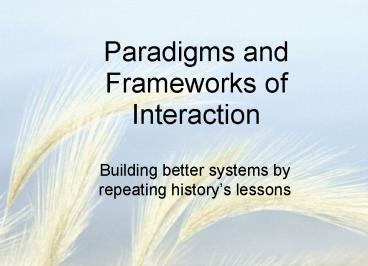Paradigms and Frameworks of Interaction - PowerPoint PPT Presentation
1 / 31
Title:
Paradigms and Frameworks of Interaction
Description:
Come up with a list of things that you found surprising about the design and the ... 50's: Semi-Automatic Ground Environment (SAGE) 60's: Sketchpad (Sutherland) ... – PowerPoint PPT presentation
Number of Views:35
Avg rating:3.0/5.0
Title: Paradigms and Frameworks of Interaction
1
Paradigms and Frameworks of Interaction
- Building better systems by repeating historys
lessons
2
Agenda
- Questions
- Talk about the movie
- History of interactive breakthroughs
- themes
- people
- Frameworks for HCI
- Intro to usability principles
3
IDEO Shopping Cart you talk.
- Come up with a list of things that you found
surprising about the design and the design process
4
Our own design process
- How can we apply IDEO lessons to our own projects?
5
History of interactive breakthroughs
- Other sources
- Rheingolds Tools for Thought
- on-line
- www.artmuseum.net/w2vr
6
Networks and time-sharing
- J.C.R. Licklider at ARPA (Advanced Research
Projects Agency) - Take advantage of increased computing power
- Batch processing -gt interactive computing
7
Video display units
- 50s Semi-Automatic Ground Environment (SAGE)
- 60s Sketchpad (Sutherland)
- allowed abstraction and visualization of data
- computer conforming to human needs, rather than
vice versa
8
Programming toolkits
- Engelbart at SRI
- Can computers teach humans?
- Allowed for bootstrapping
- People could build complex systems more quickly
and easily
9
Personal computing
- LOGO (Papert) enabled children to program using
a simple language - Smalltalk, Dynabook, vision of PCs (Kay)
- Computing more accessible to regular people
10
Windows
- WIMP (Engelbart, Xerox PARCs Alto)
- Enabled a single user to engage in multiple tasks
- Computer as a dialogue partner
11
Metaphors
- LOGOs turtle
- office desktop
- Keyboard
- Mapping new interactions to existing, familiar
concepts
12
Direct manipulation
- Shneiderman, Hutchins, Hollan, Norman
- Visibility of objects of interest
- Incremental action at the interface, rapid
feedback - Reversability of actions
- Syntactic correctness of actions
- Actions to manipulate visible actions directly
13
Language vs. action (agents)
- User understands system or interface translates
for user - Tradeoff between requiring the system to
understand the user, and user to understand the
system - Tradeoffs between language and direct manipulation
14
Hypertext/WWW
- Memex (Bush) hypothetical system
- Xanadu, hypertext (Nelson)
- Allows non-linear interaction with data and
information - WWW (Berners-Lee), Mosaic(Andreesen)
- Computing as community
15
Multi-modality
- vision and haptic, other channels, simultaneous
channels - Multiple input and output channels
- Flexibility and suitability to multiple purposes
16
CSCW
- collaboration via computers, networks
- groupware, email
- Many users, shared system, but now the users are
interacting with each other
17
Ubiquitous computing
- Tabs, pads, boards (Weiser Xerox PARC)
- PDAs, mobile phones
- Many devices per user.
18
Sensor-based and context-aware computing
- Commanding a system ? implicit interaction
- Data used to make inferences about a situation
- Controversial and still problematic
19
Frameworks for HCI
- Folk HCI
- Humans as sensory processors
- Human factors, experimental psych
- Humans as interpreters/predictors
- Cognitive psych, AI
- Humans as actors in environment
- Activity theory, ethnography, ecol psych
20
What makes a system usable
- Humans as sensory processors
- Fit with human limits
- Humans are interpreters/predictors
- Fit with knowledge and task
- Humans as actors
- Fit with task environment and social context
21
HCI Methods
- Humans as sensory processors
- Quantitative evaluation
- Humans are interpreters/predictors
- Task analysis, Cognitive walkthrough
- Humans as actors
- Ethnographic field work, participatory design
22
Two views of interaction
- Interaction with
- Software as a tool or machine
- Interface is usability-engineered membrane
- Human as processor interpreter models
- Interaction through
- Software as medium to interact with task objects
or people - Interface plays a role in social context
- Human as interpreter actor models
23
Cognitive Frameworks
- Model-Human Processor (Card, Moran and Newell)
- Situated Action (Suchman)
- Activity Theory (Vygotsky, Nardi)
- Distributed Cognition (Hutchins)
24
Intro to Usability Principles
- Formative Abstract rules that can be applied to
design - Summative Can explain why a design or paradigm
is successful or not
25
Learnability
26
Flexibility
27
Robustness
28
Learnability
- predictability
- synthesizability
- familiarity
- generalizability
- consistency
29
Flexibility
- dialog initiative
- multi-threading
- task migratability
- substitutivity
- customizability
30
Robustness
- observability
- recoverability
- responsiveness
- task conformance
31
Upcoming
- More on usability principles
- Feedback on Part 0
- Information on Part 1
- Homework 1 due May 21































